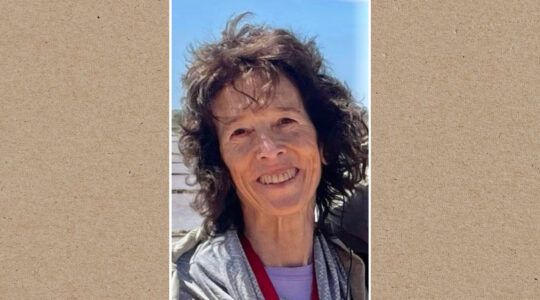Fifteen years ago, a suicide bomber carrying 15 pounds of explosives laced with bullets and metal scraps grabbed Omer Golan from behind — and blew them both up. Miraculously, Golan survived. Along with his wife, Tal Golan, he went on to become one of the most interesting new-media artists to come out of Israel.
Today, the New York-based husband-and-wife art duo, going under the collective name OMTA, is in the process of using large-scale replicas of the shrapnel extracted from Golan’s body in the most fanciful of ways — to build a children’s playground.
“After years of turning these metal pieces over and over in his hand, they began to resemble merry-go-rounds, slides, seesaws,” the couple wrote in a statement describing the imagined playground, to be called “We Live For Tomorrow.” The idea is to take the metal fragments — and thus the cause of Golan’s suffering — and transform them into objects of play. “It is about acceptance, hope, and healing,” they wrote, “about transforming horror into fantasy.”
A video installation with a digital simulation of the playground — including images of the shrapnel itself and X-rays of it inside Golan’s body — will be presented next week as part of the 14th Street Y’s “LABA” fellowship program. The video installation represents the first step in fleshing out the concept of the actual playground, explained Golan, who plans to start looking for sponsors for it after the show.
Golan said that with this project he and his wife were, as artists, stepping outside of their comfort zone. Specializing in light, playful interactive art, the two normally avoid relating to the terror attack Golan survived. “But I can’t not talk about it anymore, you know?” Golan told The Jewish Week. “It’s not about politics for me — for me it’s my life; it’s who I am.”
The terror attack took place on Dec. 21, 2000. Golan, then an IDF soldier, was sitting in a rest stop in the West Bank, waiting for a ride back to the army base and playing backgammon to pass the time. “I just rolled a gammon, I win” — it was the last coherent thought he had before someone grabbed him from behind, and the world shattered into pieces.
Golan remembers rising from the floor after the explosion to see that the man who grabbed him was dead, his backgammon partner was alive, and that he himself was on fire. He passed out again trying swat out the flames.
He woke up three weeks later in Haifa’s Rambam hospital, in critical condition. He suffered from third-degree burns, partial paralysis and complete deafness. “I was sure that I was already dead,” he noted grimly, “so when I actually woke up in the hospital, it was a nasty surprise.”
Golan slowly regained partial hearing and full use of his limbs, but the shrapnel riddling his body remained a life-threatening problem for years. Two years into his recovery, in between operations, he met his wife to-be. Though neither had any background in the arts, they began to paint together, and quickly fell in love — both with each other and with the medium. Moving with an urgency of people who don’t know how long they have together, they married within a few weeks of meeting, left Israel together (“Too many bad memories,” Omer said) and moved to Amsterdam to start a new life as artists. In November 2003, after participating in several group exhibitions, they had their first solo exhibit. Along with paintings, it featured a photograph of a shape resembling the map of Israel etched in the scars on Golan’s back. They called it “Roadmap for Peace,” after the 2003 U.S.-backed peace proposal then in the headlines.
Seeking new ways to engage and captivate viewers, the couple broke from traditional art and took to the realm of interactive art. Teaching themselves computer programming, they used motion detectors, live-feed video cameras and large-scale projectors to make the audience both the topic and the medium of their work. Their art often had to do with body image and the mutilation of it: spectators would see their own image projected on a wall, but looped through a line of code that would gradually transform it into something unrecognizable — usually something funny, sometimes something horrific.
James Tunick, owner and manager of the multimedia gallery the IMC LAB (theIMClab.com), where OMTA will be doing a residency this spring, called the couple’s artwork “delightfully original, innovative, and more often than not, technologically groundbreaking.”
The Golans now live in New York, and to this day Omer continues to suffer from various post-traumatic symptoms. But he has come a long way. In 2008, trying to confront his demons, he joined an Israeli-Palestinian art exchange project, initiated by the Bereaved Families Forum, which required him to spend a weekend in the Palestinian village of Beit Jalah, in the environment and in the vicinity of the people he still feared most.
Support the New York Jewish Week
Our nonprofit newsroom depends on readers like you. Make a donation now to support independent Jewish journalism in New York.
Though he suffered from insomnia, panic attacks and flashbacks for weeks both before and after the journey, it was also a hugely transformative experience for him. “There was I, a former IDF soldier, who was mortally wounded by a suicide bomber, sitting and having a conversation about political art, religion and music with a young Palestinian student and painter, who some years prior to this was in an Israeli prison for a failed attempt to cause an explosion against Israeli soldiers in Nablus,” he wrote in the art blog Artpolitica. “I cannot describe what I felt.”
Golan told The Jewish Week that through the Israeli-Palestinian art exchange project, “I learned firsthand the power of engaging people in conflict resolution through art. … So what we want to do in ‘We Live for Tomorrow’ is transform the meaning of these pieces of metal extracted from me … into something happy.”
The video installation of the virtual playground will be presented on Thursday, March 5, 7:30 p.m., at the Theatre at the 14th Street Y, 344 E. 14th St., as part of the “LABALIVE” series. For more details see labajournal.com or omta.co.
The New York Jewish Week brings you the stories behind the headlines, keeping you connected to Jewish life in New York. Help sustain the reporting you trust by donating today.




